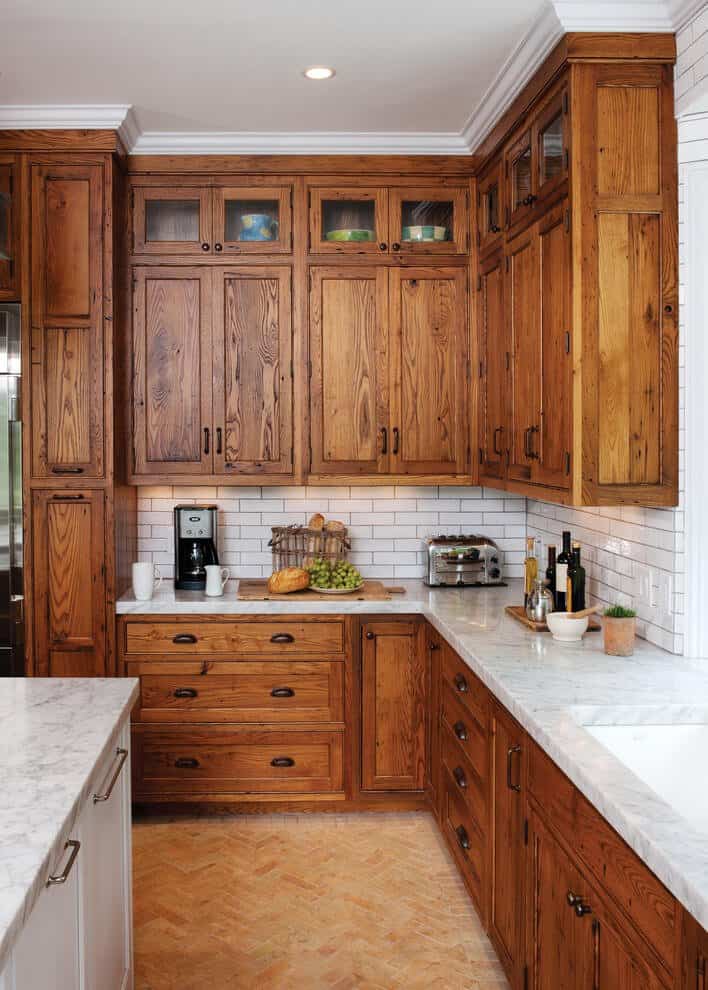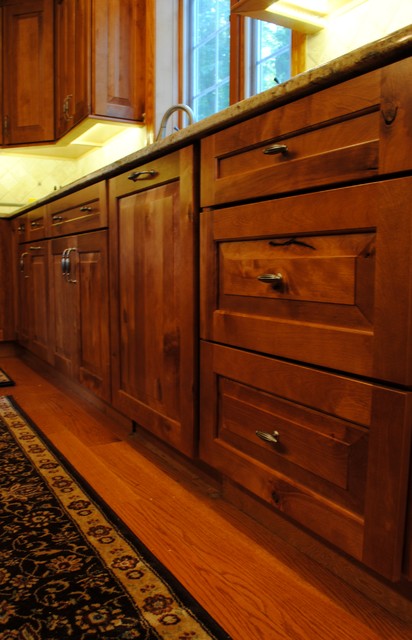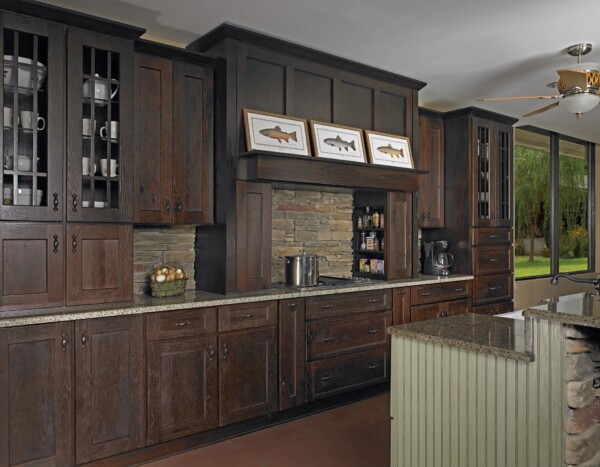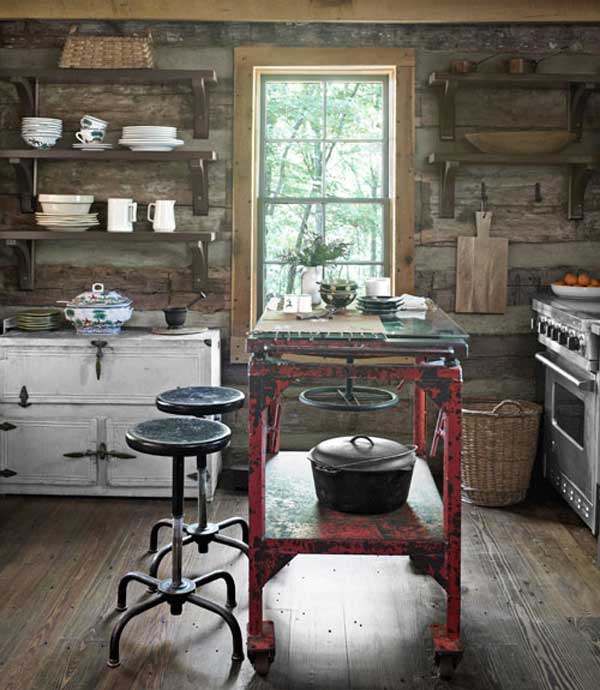Rustic kitchen cabinet designs bring warmth, character, and a timeless appeal to any kitchen space. They offer a blend of traditional charm and modern functionality, making them a popular choice for homeowners who wish to create a cozy and inviting kitchen environment. We will discuss about various aspects of rustic kitchen cabinet designs, exploring materials, finishes, styles, color schemes, hardware, and maintenance tips to help you achieve the perfect rustic look for your kitchen.

Materials for Rustic Kitchen Cabinets
Natural Wood Choices
When it comes to rustic kitchen cabinets, natural wood is the quintessential material. Woods like oak, pine, hickory, and alder are highly favored for their durability and beautiful grain patterns. Oak is particularly popular due to its strength and distinctive grain, which adds a rich texture to the cabinets. Pine, with its softer texture and knots, offers a more traditional and rugged look. Hickory is known for its striking color variation and strong grain patterns, making each cabinet unique. Alder, with its smooth texture and consistent grain, is easier to work with and stain, allowing for versatile design options.
Reclaimed Wood
Reclaimed wood is another excellent choice for rustic kitchen cabinets. It not only contributes to the rustic aesthetic but also promotes sustainability by reusing old wood. This type of wood often comes from barns, old houses, and factories, bringing a piece of history into your kitchen. Reclaimed wood is appreciated for its weathered look, patina, and unique imperfections, such as nail holes and knots, which add to its rustic charm. Each piece of reclaimed wood tells its own story, making your kitchen cabinets one-of-a-kind.

Plywood and MDF with Veneer
For those seeking a rustic look without the expense of solid wood, plywood and MDF (Medium Density Fiberboard) with wood veneer are viable alternatives. Plywood is made from thin layers of wood glued together, offering strength and stability. When topped with a wood veneer, it mimics the appearance of solid wood at a lower cost. MDF, made from wood fibers and resin, provides a smooth surface that is ideal for painting or applying veneer. Veneers made from oak, cherry, or walnut can give your cabinets a rustic appearance while keeping costs down.
Metal Accents
Incorporating metal accents into rustic kitchen cabinets can enhance their rugged appeal. Metal materials such as iron, copper, and steel can be used for hardware, trim, or even as a structural element within the cabinets. These materials add a touch of industrial chic to the rustic design, providing a balance between natural and man-made elements. Iron handles and hinges, copper inlays, and steel brackets are just a few examples of how metal can be seamlessly integrated into rustic kitchen cabinets.

Finishes for Rustic Cabinets
Distressed Finishes
Distressed finishes are a hallmark of rustic kitchen cabinet designs, giving new cabinets an aged, worn look. This finish is achieved through various techniques such as sanding, scraping, and applying layers of paint or stain, then removing some to reveal the underlying wood. The result is a cabinet that looks like it has weathered many years of use. This technique adds character and depth to the cabinets, making them a focal point in the kitchen. The level of distressing can be customized, from light wear to heavily distressed surfaces.
Hand-Painted Finishes
Hand-painted finishes provide a personal touch to rustic kitchen cabinets. This method involves applying paint by hand rather than using a spray gun, resulting in a more textured and less uniform appearance. Popular colors for rustic cabinets include shades of white, cream, soft greens, and blues, which can give the kitchen a vintage farmhouse feel. The hand-painted technique can also include decorative elements such as floral motifs, stencils, or distressed edges, adding an artisanal quality to the cabinets.
Stained Wood Finishes
Stained wood finishes enhance the natural beauty of the wood grain, offering a rich and warm appearance that is perfect for rustic kitchens. Stains come in a variety of shades, from light honey tones to deep, dark browns, allowing homeowners to choose a finish that complements their kitchen decor. Staining also protects the wood, making it more durable and resistant to moisture and wear. This finish is ideal for those who want to showcase the natural characteristics of the wood while maintaining a rustic aesthetic.
Wax and Oil Finishes
Wax and oil finishes are traditional methods for treating wood, providing a natural and matte appearance that enhances the rustic look. These finishes penetrate the wood, bringing out its natural color and grain while offering protection. Unlike varnish or lacquer, wax and oil finishes do not create a glossy surface, keeping the wood looking authentic and aged. Regular application of wax or oil can maintain the finish and keep the wood in good condition. This type of finish is perfect for homeowners who prefer a low-sheen, natural look for their rustic kitchen cabinets.

Styles of Rustic Kitchen Cabinets
Shaker Style
Shaker-style cabinets are a popular choice for rustic kitchens due to their simplicity and timeless appeal. Characterized by their clean lines, flat panel doors, and minimal ornamentation, Shaker cabinets embody a functional and utilitarian aesthetic that fits well with rustic decor. The focus on craftsmanship and durability aligns with the rustic theme, while the understated design allows the natural beauty of the wood to shine. Shaker cabinets can be made from various types of wood and finished with stains or paints that enhance their rustic charm.
Beadboard Cabinets
Beadboard cabinets feature vertical planks with a distinctive bead running between each board, offering a textured and cottage-like feel. This style is reminiscent of old-fashioned paneling used in farmhouses and cottages, making it an excellent choice for rustic kitchen designs. Beadboard cabinets can be painted or stained to match the overall color scheme of the kitchen. The vertical lines of the beadboard add visual interest and depth to the cabinets, creating a cozy and inviting atmosphere.
Open Shelving
Open shelving is a practical and aesthetically pleasing option for rustic kitchens. Instead of traditional closed cabinets, open shelves allow for easy access to kitchen essentials while showcasing rustic elements such as reclaimed wood, metal brackets, and vintage dishware. This style creates an airy and open feel in the kitchen, making it appear larger and more welcoming. Open shelving can be combined with closed cabinets to balance storage needs and display opportunities, enhancing the rustic charm of the space.
Farmhouse Cabinets
Farmhouse-style cabinets are synonymous with rustic kitchen designs, featuring a blend of traditional and functional elements. These cabinets often have a distressed finish, shaker doors, and decorative hardware that evoke a sense of nostalgia and simplicity. Farmhouse cabinets are typically made from sturdy woods like oak or pine and finished in warm, neutral colors. The design emphasizes practicality and durability, with ample storage space and easy-to-clean surfaces, making them ideal for busy kitchen environments.

Color Schemes for Rustic Kitchens
Earth Tones
Earth tones are a natural fit for rustic kitchen cabinets, providing a warm and inviting atmosphere. Colors like brown, beige, and taupe mimic the hues found in nature, creating a harmonious and cohesive look. These colors complement the natural wood elements and can be used on cabinets, walls, and countertops. Earth tones can range from light to dark shades, allowing for versatility in design. They create a soothing and comfortable environment, perfect for a rustic kitchen.
Muted Greens and Blues
Muted greens and blues add a touch of color to rustic kitchens without overwhelming the space. These shades evoke the tranquility of the outdoors, blending seamlessly with natural wood and other rustic elements. Soft sage green, pale blue, and gray-blue are popular choices that provide a subtle contrast to the warm tones of wood. These colors can be used on cabinet doors, islands, or as accent colors, creating a calm and serene kitchen environment.
Warm Whites and Creams
Warm whites and creams are classic choices for rustic kitchen cabinets, offering a bright and airy feel while maintaining a cozy ambiance. These neutral shades work well with any wood type and finish, providing a versatile backdrop for other design elements. Off-white, ivory, and cream colors reflect light, making the kitchen appear larger and more inviting. They can be used on all cabinets or combined with wood tones to create a balanced and harmonious look.
Bold Accents
For those who want to add a touch of drama to their rustic kitchen, bold accent colors can be incorporated into the cabinet design. Deep reds, navy blues, and forest greens can be used sparingly on kitchen islands, upper cabinets, or as a backdrop for open shelving. These bold colors add depth and contrast to the rustic decor, creating focal points and enhancing the overall aesthetic. When used thoughtfully, bold accents can bring a modern twist to traditional rustic designs.

Hardware for Rustic Kitchen Cabinets
Metal Handles and Knobs
Metal handles and knobs are essential elements in rustic kitchen cabinet designs, adding both functionality and style. Iron, brass, and copper are popular choices for their durability and vintage appeal. Wrought iron handles and knobs provide a rugged and industrial look, while brass and copper add warmth and elegance. These metals can be finished in various ways, from polished to antiqued, to match the overall aesthetic of the kitchen. The choice of hardware can significantly influence the look and feel of the cabinets, making it an important design consideration.
Wooden Handles
Wooden handles offer a seamless and cohesive look for rustic kitchen cabinets. They can be made from the same wood as the cabinets or a contrasting type to add visual interest. Wooden handles are typically simple in design, emphasizing the natural beauty of the material. They can be stained or painted to match the cabinet finish or left in their natural state for a more organic look. Wooden handles add a touch of warmth and authenticity to the kitchen, enhancing the rustic charm.
Antique and Vintage Hardware
Incorporating antique and vintage hardware into rustic kitchen cabinets can add a unique and personalized touch. Salvaged hardware from old furniture, farm equipment, or antique stores can be repurposed for cabinet doors and drawers. This type of hardware often has intricate designs and a patina that adds character and history to the cabinets. Using antique hardware creates a sense of nostalgia and authenticity, making the kitchen feel like a well-loved and lived-in space.
Functional Hardware
Functional hardware such as soft-close hinges, drawer slides, and pull-out shelves are important for the modern functionality of rustic kitchen cabinets. These elements ensure that the cabinets operate smoothly and efficiently while maintaining their rustic appearance. Soft-close hinges prevent doors from slamming, preserving the integrity of the wood. Pull-out shelves and organizers make it easier to access items, enhancing the practicality of the kitchen. Integrating modern hardware with rustic design elements creates a perfect blend of old and new.

Maintenance Tips for Rustic Kitchen Cabinets
Regular Cleaning
Regular cleaning is essential to maintain the beauty and longevity of rustic kitchen cabinets. Dust and dirt can accumulate on the surfaces, dulling the finish and causing wear over time. A soft cloth and mild soap solution can be used to wipe down the cabinets, removing any grime without damaging the wood. It is important to avoid abrasive cleaners or scrubbing pads, as they can scratch and damage the finish. Regular cleaning not only keeps the cabinets looking their best but also prolongs their lifespan.
Protecting the Finish
Protecting the finish of rustic kitchen cabinets is crucial to preserving their appearance. Applying a protective coat of wax or oil can help maintain the wood’s natural luster and prevent moisture damage. These finishes should be reapplied periodically, depending on the level of use and exposure to moisture. It is also important to address any spills or stains immediately to prevent them from setting into the wood. Using coasters and placemats can help protect the surface from heat and moisture.
Repairing Damage
Despite the best efforts, rustic kitchen cabinets may still suffer from occasional damage such as scratches, dents, or stains. Small scratches can be addressed with a wood touch-up pen or wax stick that matches the cabinet’s color. Dents can often be repaired by applying a damp cloth and a warm iron to the area, which can help the wood swell and reduce the dent. For more significant damage, it may be necessary to sand and refinish the affected area. Keeping a small amount of the original stain or paint on hand can make these repairs easier.
Preventing Moisture Damage
Preventing moisture damage is a key aspect of maintaining rustic kitchen cabinets. Wood is particularly susceptible to water damage, which can cause warping, swelling, and discoloration. Installing a good-quality range hood and ensuring proper ventilation can help reduce moisture levels in the kitchen. It is also important to fix any plumbing leaks promptly and use sink mats to protect the cabinet surfaces around the sink. Ensuring that spills are wiped up immediately and using a dehumidifier in humid climates can also help prevent moisture damage.

Common Mistakes to Avoid
Overdoing the Distressed Look
While distressed finishes are a hallmark of rustic design, it’s easy to go overboard. Excessive distressing can make cabinets look overly worn and unappealing rather than charmingly rustic. Balance is key; aim for subtle wear that suggests age without making the cabinets appear neglected.
Ignoring Functionality
Rustic design should not come at the expense of functionality. Ensure that the cabinets provide adequate storage and are easy to use. Modern hardware like soft-close hinges and pull-out shelves can maintain functionality while preserving the rustic aesthetic.
Inconsistent Design Elements
Consistency is important in design. Mixing too many different wood types, finishes, or styles can result in a disjointed look. Stick to a cohesive color palette and style to ensure a harmonious and unified kitchen design.
Skipping Proper Maintenance
Neglecting maintenance can quickly lead to deteriorated cabinet appearance and functionality. Regular cleaning, protecting finishes, and addressing damage promptly are essential to keeping rustic kitchen cabinets looking their best.
Choosing Inappropriate Hardware
The hardware should complement the rustic style. Modern, sleek hardware can clash with rustic designs. Opt for metal or wooden handles that enhance the rustic charm and ensure they are durable and functional.

What are the best woods for rustic kitchen cabinets?
The best woods for rustic kitchen cabinets are oak, pine, hickory, and alder. Oak is valued for its strength and prominent grain, pine offers a traditional look with its knots and soft texture, hickory provides striking color variation and strong grain patterns, and alder is appreciated for its smooth texture and ease of staining.
How do I achieve a distressed finish on my kitchen cabinets?
To achieve a distressed finish, start by sanding the cabinets to remove any existing finish. Apply a base coat of paint or stain and let it dry. Then, use sandpaper, steel wool, or a scraper to remove some of the top layers, focusing on edges and corners to mimic natural wear. Finish with a protective top coat to seal the look.
Can I mix modern elements with rustic kitchen cabinets?
Yes, mixing modern elements with rustic kitchen cabinets can create a balanced and eclectic look. For example, modern appliances and lighting can contrast beautifully with rustic cabinets, creating a harmonious blend of old and new. Just ensure the overall design remains cohesive.
How do I maintain rustic kitchen cabinets?
Maintaining rustic kitchen cabinets involves regular cleaning with a soft cloth and mild soap solution, protecting the finish with periodic applications of wax or oil, repairing any damage such as scratches or dents promptly, and preventing moisture damage by ensuring proper ventilation and addressing spills immediately.
Are reclaimed wood cabinets durable?
Yes, reclaimed wood cabinets can be very durable. The wood used is often from old-growth trees, which is typically denser and stronger than new wood. Additionally, reclaimed wood has already been exposed to changes in humidity and temperature, making it more stable and less prone to warping or cracking. Proper sealing and maintenance can further enhance their durability.
Rustic Kitchen Cabinetry – The Best Home Design

Simple Rustic Homemade Kitchen Islands

Brown Kitchen Cabinet Designs, Ideas Design Trends

How To Match Cabinet Hardware with Kitchen Decor Backsplash with dark cabinets, Rustic kitchen

Related Posts:
- Adjusting Kitchen Cabinets
- How To Freshen Up Kitchen Cabinets
- Heavy Duty Kitchen Cabinet Hinges
- How To Paint Kitchen Cabinets Distressed White
- Demo Kitchen Cabinets For Sale
- Glass Kitchen Cabinet Doors Replacement
- Fancy Kitchen Cabinets
- Kitchen Backsplash White Cabinets Brown Countertop
- Kitchen Cabinet Color Ideas
- Metal And Wood Kitchen Cabinets